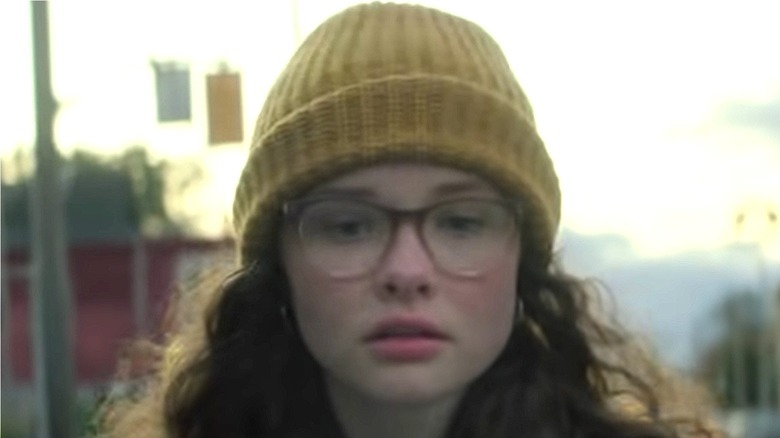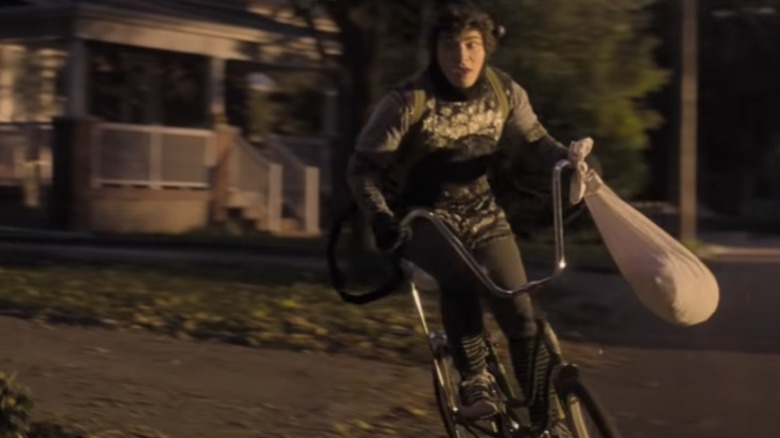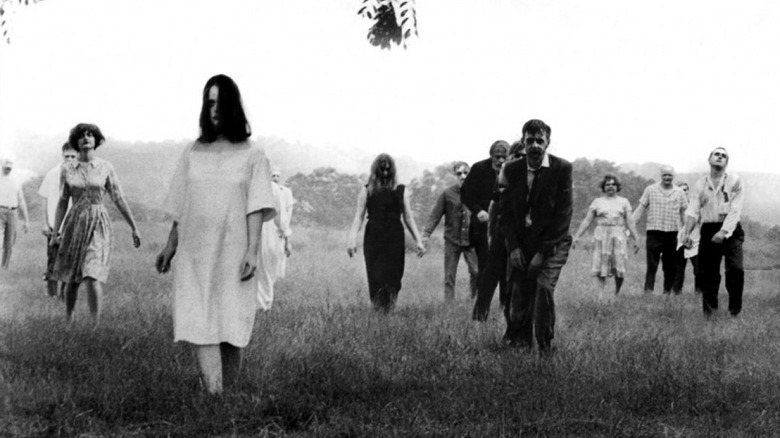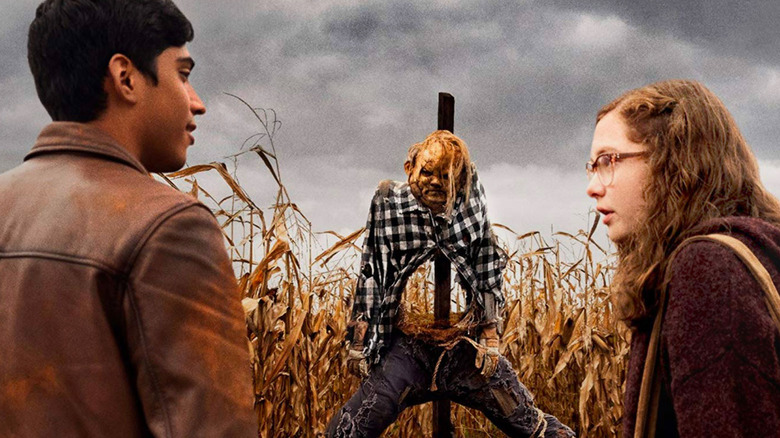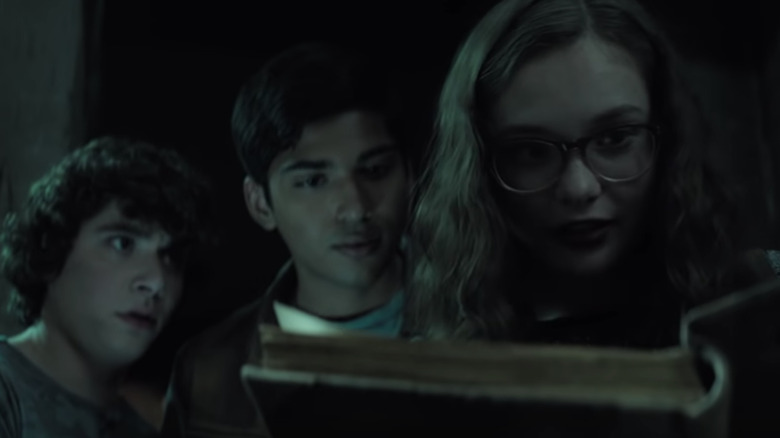The Horror Movie References You Missed In Scary Stories To Tell In The Dark
In 2019, Andres Øvredal flicked through a beloved horror series of books and pulled out some of the most feared entries to stitch a big screen adaptation together, and the result wasn't half bad at chilling bones in the process. "Scary Stories to Tell in the Dark" brought to life a collection of the most terrifying spooks and sinister beings that Alvin Schwartz ever had the displeasure of imagining, all on the hunt for a group of kids who went to the wrong house and picked up the wrong book without asking. Classic horror scenario, right?
However, while the influence of the Schwartz books is obvious, Øvredal also used his movie to pay homage to some classic horror cinema. From the subtle moments to the more on-the-nose ones, here are the best little tributes that Øvredal made an effort to include in "Scary Stories to Tell in the Dark" ... you know, between all the screaming.
Adding Amblin to the atmosphere
While "Scary Stories to Tell in the Dark" is set in 1968, there's an undeniably distinctive tone throughout the film that echoes that of beloved fright fests from the 1980s — and, to be precise, the iconic Amblin era. Feeling partly like an adventure film in the same vein as "The Goonies," but with the terror of "Poltergeist," it's something that even Øvredal acknowledged he couldn't ignore. On the film's special features for the home release, he described "Scary Stories to tell in the Dark" as being "a mix between a modern horror movie, and a throwback to the Amblin movies I grew up with."
That said, while the influence is clear, in an interview near the movie's arrival in theatres, Øvredal also told Slash Film that he made an effort to avoid replicating what had come before. "I don't want to get too close, because they're in my spine in a way," he explained. "I'm trying to reference as little as possible when I make a movie, and that's a rule I generally have."
Night of the Living Dead Drive-Thru
While this adaptation of Alvin Schwartz's work may be leaning heavily towards spooky goings-on from ghostly threats, that doesn't stop Øvredal's attempt to pay his respect to other classic sub-genres, as well — which is understandable, really. Given that Stella and her pals are running scared in the year 1968, it would be almost sacrilege for the filmmakers not to tip their hat (while avoiding exposed braaains) for one classic that came out that very same year.
Early in the film, our cadavers-to-be have crossed paths with the school bully, Tommy Milner (Austin Abrams), who chases them into a drive-thru theatre where none other than George A. Romero's classic debut, "Night of the Living Dead," is playing. While what looks to be the final act of the zombie king's big-screen introduction to the undead plays out, Stella and co. are laying low in Ramón's (Michael Garza) car before Tommy catches up with them. The thug could easily be overly aggressive as school bullies are, but in a clear nod to the feature playing during the encounter, an intoxicated Tommy instead slowly knocks on Ramone's car window, echoing the monsters on the big screen.
What's your favorite Universal movie monster, Stella?
Like many other horror fans who have saved the day in their terrifying tales, Stella loves a fright or two herself, as is apparent when we first get a look in her bedroom. Before the carnage even commences, it's established that Stella is schooled on some of the horror icons that viewers love (particularly when it comes to classic Universal monsters), and that she shares their affinity for them.
Besides paint kits of the Creature from the Black Lagoon, there are some gorgeous posters all over her walls. In fact, while Stella sits stewing about being stuck in a town that she's desperate to get out of, the camera drifts across prints of "The Vampire Bat" from 1933 and "Frankenstein's Daughter" from 1958, as well as close-up shots of Universal horror legend Bela Lugosi as Dracula as well as "The Invisible Ghost" from 1941. There are also glimpses of a poster for "The Indestructible Man" from 1956 and what appears to be a Swamp Thing-like creature, confirming that when evil forces begin to bring down her friends, Stella has done enough at-home schooling to be the final girl.
Sarah Bellows tribute cover to Pan's Labyrinth
As this film marks a big step in Øvredal's Hollywood journey from unknown filmmaker to growing name in horror, it's only fitting that he paid his respects to another revered filmmaker who had a hand in helping to bring this one to the screen — and that's the Oscar-winning director Guillermo Del Toro, who produced "Scary Stories to Tell in the Dark."
Øvredal leaves a physical memento in "Scary Stories to Tell in the Dark" that is a nod to one of Del Toro's most beloved films, which was a breakthrough entry in his career: If Sarah Bellows' storybook looks familiar, it's because it's the same design as the book Ophelia reads from in Del Toro's 2006 dark fairytale epic, "Pan's Labyrinth" to take on her quest given to her by the Faun. This reference is very subtle, but it is definitely a lovely gesture to a director who not only has been one of the most impactful genre filmmakers of this era, but also no doubt had a creative influence on this film, as well, behind the scenes. This reference will also, undoubtedly, make you want to queue up Del Toro's classic fantasy when you're done with this story, as well.
